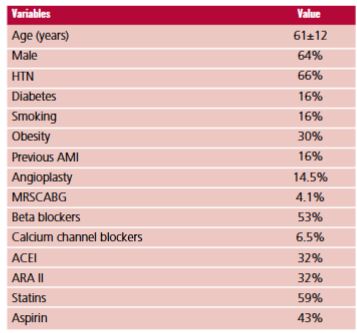Contractile and chronotropic reserve assessment in stress echocardiography studies negative for myocardial ischemia
pp. 413-419
DOI:
https://doi.org/10.7775/rac.es.v90.i6.20569Keywords:
Echocardiography, Stress, Ventricular Dysfunction, Left, Fractional Flow Reserve, MyocardialAbstract
Background: While the primary objective of the stress echocardiography (stress echo) is to assess wall motion abnormalities, evaluation of other variables, such as contractile reserve (CR) via elastance, and chronotropic reserve (ChR), may add
prognostic value to the study. However, these are unusually evaluated or reported in most stress echo studies in our field.
Objectives: To compare clinical and echocardiographic characteristics in patients undergoing an exercise stress echo with
negative results for myocardial ischemia based on the presence or absence of CR and ChR.
Methods: A rRetrospective study in 73 patients, with exercise stress echo and no ischemia. Patients were divided into three
groups, based on the presence or absence of CR and ChR. Group 1: presence of both; Group 2: presence of either of the two,
and Group 3: absence of both. The CR was established using as the systolic blood pressure and end-systolic volume ratio, both
at rest and under stress (normal value: >2), and the ChR was defined as a more than 80% increase in baseline heart rate.
Results: The study enrolled 73 patients (64% males, aged 63±12 years). Group 1 included 23 patients (62% males, agedaged
59.8±12.5 years); Group 2 included 29 patients (65% males, aged 60.7±13 years), and Group 3 included 21 patients (65%
males, aged 68.8±7.8 years). Patients with no reserve were older and showed a tendency to higher prevalence of traditional this group had lower values of left ventricular ejection fraction (LVEF) and global longitudinal strain (GLS) both at rest and
under stress, a larger ventricular mass, and less minutes of exercise according toin the exercise stress test. A binary logistic regression was performed using variables associated with the absence of CR and ChR. Age (OR 1.12, 95% CI 1.02-1.22;
p=0.01) and GLS at rest (OR 0.68, 95% CI 0.51-0.90; p=0.008) were variables independently associated with the absence of
both reserves. On a ROC curve, a GLS of -18% was the best cutoff point (area under the curve 0.72).
Conclusion: Patients with a stress echo negative for myocardial ischemia and absence of CR and ChR have a higher risk profile.
This could be associated with a higher risk of cardiovascular events during the follow-up.

Downloads
Published
Issue
Section
License
Copyright (c) 2023 Argentine Journal of Cardiology

This work is licensed under a Creative Commons Attribution-NonCommercial-ShareAlike 4.0 International License.













